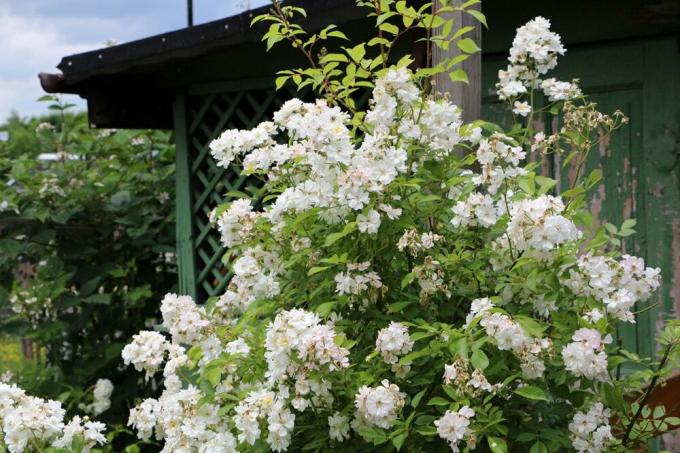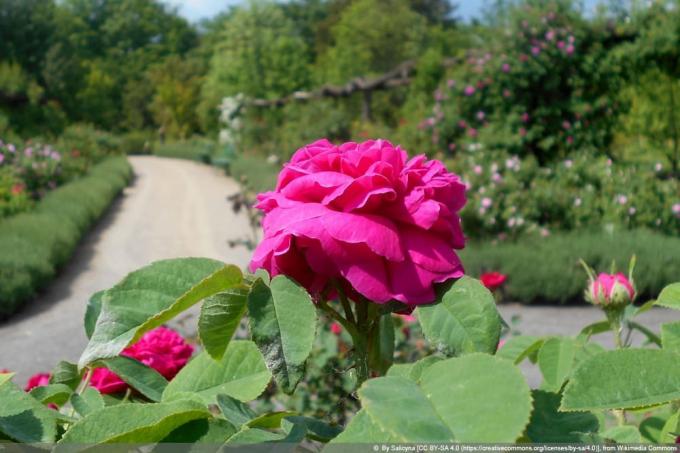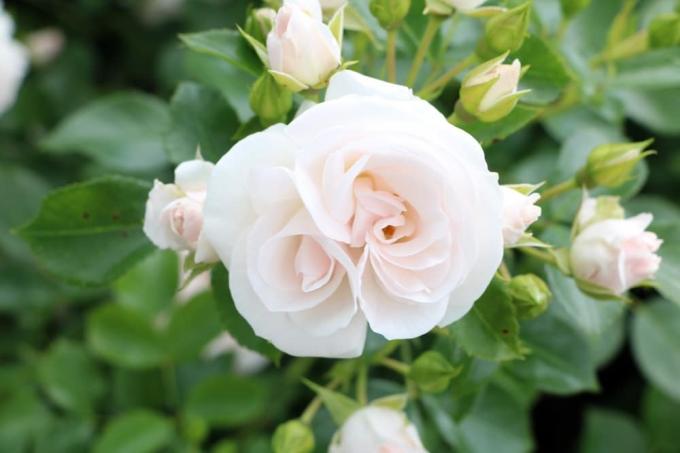

Table of contents
- Why is winter protection recommended?
- Preparations begin in the summer
- The ideal time is in November
- Pile up bed, shrub and hybrid tea roses
- Fleece hood shields crown
- Preparing tall stems for winter
- Special case climbing roses
- Winter coat for tubs and boxes
- Remove winter protection precisely
- No winter protection for wild roses and ground cover roses
If rose gardeners take the right protective measures, winter will lose its horror for the queen of flowers. Crown, trunk, grafting site and roots benefit from a warm winter coat to keep frost and snow from causing damage. A proven basic principle using fleece, bark mulch & Co sets the course. The specific procedure takes into account the respective rose type. This guide explains in detail and comprehensibly when and how to winterize roses.
Why is winter protection recommended?
Many rose varieties with limited winter hardiness have to pay for their lavish blooms. The blazing winter sun, frost and drought stress put the resilience of roses to the test. This is made more difficult when a repeated change from frosty to mild temperatures pulls on the plant tissue. Rose bushes should not be at the mercy of these hardships. It is important to winterize the shoot base and grafting point at the right time. For this purpose, prudent rose gardeners have a wide range of suitable materials at their disposal, tailored to the type of rose in question.
Preparations begin in the summer
As a prelude to expert winter protection for roses, the care program is modified in the summer. In order for young shoots to harden in time, the right supply of nutrients is important. As an engine of growth, nitrogen is unfavorable at the end of the season. From August, fresh shoots have nothing to oppose the first frosts and freeze back. Pathogens, rot and mold have an easy time at these damaged areas, so that the affected rose is doomed. How to properly prepare roses for the upcoming winter:
- Stop giving rose fertilizers that are rich in nitrogen after July
- Instead, fertilize with patent potash at the end of August
- Alternatively, in July and August, shower the root slices with potassium-rich comfrey manure
One of the special properties of potassium is that the main nutrient strengthens the cell walls in plant tissue. This is of particular advantage when, in winter, permanent temperature changes combined with sunshine pull on the tissue cells. Furthermore, potassium is able to lower the freezing point in the cell water.
Tip:
The starting signal for the perfect winter protection of your roses is given on the day of planting. Insert the young bushes so deep that the grafting point is at least five centimeters below the ground. The neuralgic spot can be seen as a slight thickening in the transition from roots to crown shoots.
The ideal time is in November
North of the Alps, the time window for winter protection of roses opens at the beginning of November. As long as the golden October sun warms the bed and balcony, hasty measures are associated with the risk of causing heat build-up. Only when the temperatures drop permanently below the 10 degree mark and move towards the freezing point is the ideal time to winterize roses.
Pile up bed, shrub and hybrid tea roses
Mounding up the shoot bases plays a key role in the winter protection of roses. The frost-sensitive area of grafting and branch base receives a natural bulwark against frost and moisture. How to do it right:
- Cover the shoot base of rose bushes with 15 to 20 cm of soil
- Ideally, top with a mix of compost and topsoil
- Alternatively, lay out a coconut mat on an underlayer of autumn leaves or straw
- Cover branches protruding from a mound of earth with needle sticks
The additional covering with needle brushes fulfills two tasks. Above all, densely needled branches slow down the icy east wind and prevent frost cracks caused by the sun's rays. In addition, fir fronds give the unsightly mounds of earth a decorative touch.
A notice:
Bark mulch is unsuitable for piling up roses in beds. First and foremost, the crushed bark of conifers gives off an excess of tannic acid, which the noble ornamental trees do not like. In addition, it proves to be a difficult task to remove the decomposing bark mulch in the spring.
Fleece hood shields crown
Winter protection of head-high shrub and hybrid roses requires a more extensive measure. Heaping up the base of the shrub and covering with needles is not enough because the crown is not or only partially included. Specialist retailers offer breathable fleece hoods for this purpose. Put the hood loosely over all the rose shoots and pull the open end together with strings above the piled-up earth. Alternatively, wrap all branches with jute ribbons or a comparable, weatherproof and breathable fabric. Foil is not suitable as crown protection for roses. Condensation forms under the watertight and airtight material within a short time, which inevitably causes rot.
Preparing tall stems for winter

Opulent roses shine in the imaginative design of the bed and balcony, their picturesque crown enthroned on a trunk as a robust base. The sensitive grafting point is at the base of the crown, which requires an alternative strategy for experienced winter protection. In addition, the trunk bark is subject to the risk of stress cracks when the sun's rays suddenly hit it on cold days. With a combination of crown and trunk protection, you arm your rose trunk against the rigors of winter. That is how it goes:
- Put the fleece hood over the crown
- Tie together below the grafting point on the trunk
- Wrap the trunk with jute or fleece ribbons
In regions with harsh winters, we recommend protecting the wrapped trunk with mats made of reed or coconut.
Tip:
Please do the last rose cut of the season several weeks before the first frost. Rose bushes pruned shortly before the onset of winter are at massive risk from frost damage to total failure. If in doubt, postpone trimming until next spring. The best time for the main cut is during the forsythia bloom.
Special case climbing roses
Attempting to equip climbing roses with a hood is doomed to failure. Nevertheless, the long tendrils of climbers and ramblers should not go through the winter without protection. Resourceful rose gardeners use the following options to guide roses on the trellis through the cold season unscathed:
- At the beginning, pile up the base of the shrub 20 cm high and cover it with fir fronds
- Hang needles in the climbing rose to break the icy wind
- Optionally set up winter protection mats made of coconut, reed, straw or heather herb
Don't worry if a stray vine doesn't survive the winter. All roses tolerate pruning well. Wait for this year's budding to see frozen wood sections. In April or May, cut the damaged climbing rose back into the healthy wood as part of the annual pruning care. As long as the grafting point survives the winter healthy, a rose will sprout vigorously again.
Winter coat for tubs and boxes
In the planters, the root ball of a rose is in an exposed position and vulnerable to severe frost. A thick winter coat and warm feet ensure that the roots do not freeze. How to winterize roses in pots and boxes:
- Tub and box move to a wind-protected niche in the wall
- Push a block of wood, styrofoam panels or plant rollers underneath
- Cover the container with bubble wrap, jute, fleece or coconut mats
- Important: Leave floor openings free to protect against waterlogging
- Protect the crown with a hood made of fleece
- Cover the substrate with straw, coconut discs or compost

Resourceful balcony gardeners place tubs and boxes in a larger container or a jute sack and stuff the cavities with bark mulch. All winter protection is useless when roses wither in pots and boxes. The soil dries out quickly in winter, especially in protected planters. On mild days, please thumb test the soil's moisture level to water moderately on dry days.
Remove winter protection precisely
A look at the calendar only provides limited information as to when you should remove the winter protection from your roses. After all, the right time has to be chosen carefully. In the worst case, a premature date will helplessly expose the noble flowering shrubs to late frosts. Winter protection that is removed too late carries the risk of rot and mold growth. The decisive clue for the ideal time comes from nature. When the forsythias bloom, winter protection on roses has done its duty.
No winter protection for wild roses and ground cover roses
You can remove protective measures for the winter time from the care program if wild and ground cover roses adorn your garden. Both types of roses thrive ungrafted and without a sensitive grafting point. In connection with a pronounced vigor and reliable winter hardiness, these rose forms fearlessly face the floral front in the cold season.
 garden editorial
garden editorial I write about everything that interests me in my garden.
Learn more about types of roses

Pruning wild roses: 6 tips for trimming wild roses
Wild roses should not be missing in any natural garden. They are easy to care for and bloom on two-year-old wood. The delicate blossoms and autumnal rosehips enchant the garden well into winter. To maintain their beauty, however, some maintenance is necessary.

18 historical roses with picture | Varieties of roses for the home garden
Creating a rose garden is not as easy as you might think. The gardener often only becomes aware of the variety of different flower colors on the market when the purchase decision is imminent. So that the selection does not have to be made spontaneously and that it takes into account both the appearance and the location requirements can be optimally adapted to the circumstances of his garden, he will find an overview of 18 historical ones here varieties of roses.

Moss rose (Rosa centifolia var. muscosa): care from A to Z
The moss rose (Rosa centifolia var. Muscosa) is a profusely flowering old rose variety that resulted from a bud mutation. The special thing about her is the green to brownish moss on the buds, sepals and flower stalks and their sweet, slightly resinous scent.

Create a rose bed: easy to care for with roses, perennials and stones
The rose is not considered the queen of flowers for nothing. Her beauty is simply incomparable. It goes without saying that under these conditions it belongs in every garden. Here you can learn how to properly plant a rose bed and properly care for the royal plants.

Tub roses: rose care in the pot | Repot roses properly
In the summer months, the balcony and terrace can be embellished with blooming roses, as these flowers can also be planted in tubs. However, due to the deep roots, there are some important factors to consider when choosing the planter, location, care and repotting.

Rose planting time: when is the best time to plant roses?
Roses have the potential to spark a passion for collecting. Each strain is different, be it flower shape or color. With these noble flowers, there is never a dull moment in the garden. When is the best time to plant new roses?
